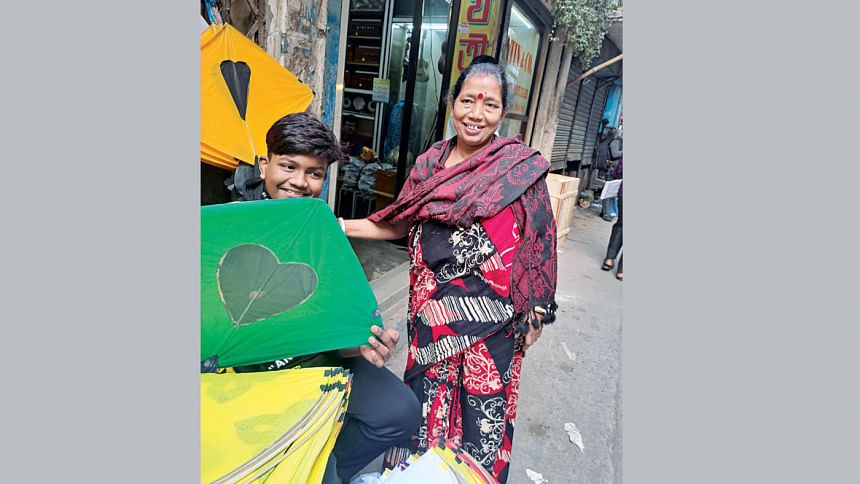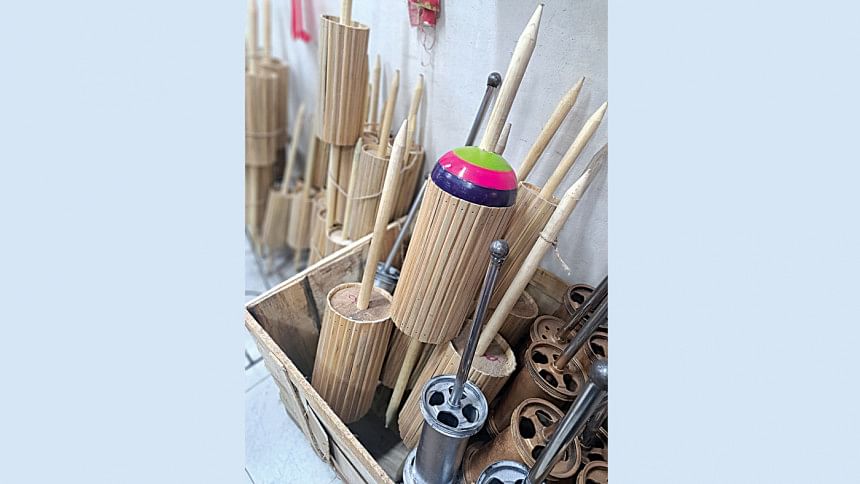Shakrain Celebrations: The art, culture and controversies of a kite festival

Every mid-January, in the city we call home, colourful kites take flight brushing against the northern wind. Kites are so much more than pieces of coloured paper; there are passionate stories related to them and entire cult followings. According to Hindu scriptures, Shakrain or Makar Sankranti is the celebration of the sun's journey from the Southern to the Northern Hemisphere. The Sun god is worshipped for good harvest and the day is celebrated on January 14, on the last day of the Bangla month of Poush.
Samar Nandi has been in the trade for over 50 years and his tiny kite store, Shonkho Niketon, is a living testament to the popularity of this annual, Hindu festival symbolising unity and friendship of the community.
"It is a heritage of Old Dhaka. Kolta Bazar, Dholaikhal, Gandaria, Islampur, and adjoining areas are the neighbourhoods where the celebrations become most visible," said Nandi. "There is an art in flying kites. I started making them for myself at the age of 15 and later took it up as a profession. I make about 100 kites a day and each design has a name -- Chokhodhan, Boadhan, Tekkadhan, Do Baaz, Ponkhi, and many more."
Nandi also sources kites in bulk from a master kite-maker known as Hashem chacha. The kites by Hashem chacha are some of the major attractions of Shonkho Niketon.

Since the start of January, the small shop of Samar Nandi has been abuzz with activities. The entire lane of Shankhari Bazaar wears a colourful, festive vibe. Sale is at its peak and almost every small vendor, even the cha wallahs and vegetable sellers, shift gears to cash in on the seasonal trade.
The making of the kite requires dolu bash (Assamese bamboo) or muli bash, found in the Sylhet and Kaptai regions of the country. The thinly shaped cane helps to connect the corners of the kite and provide support. Kite makers prefer coloured paper imported from China or India. The paper is glazy, hard and does not tear easily.

The thread used to fly kites is worked upon and in the olden days, this used to be known as "Manja" -- the string was passed through a mixture of ground glass powder and glue, making it abrasive. The whole purpose of this exercise was to make the strings sharp enough to easily sever the competitor's kites during a fight.
"Strings are a big business during Makar Sankranti and several different types of string, imported from China and India, are now available. The old glass-coated Manja is no longer in use," explained Nandi.
Diamond-shaped kites are often considered the easiest to fly. Its simple design and balanced structure make it stable in the air, making it a good choice for beginners and children. November to January is the perfect time when the favourable northern wind assists kite flying.
Zahid Sharif, an entrepreneur and former resident of Old Dhaka is a Shakrain enthusiast and believes that the fervour of the whole festival of kite is unmatched in terms of gaiety. The main attraction is kite fighting -- the competition to snag each other's kites or cut the other's kites down.
"The kite becomes me and I feel as if I am soaring high up in the sky. It gives me freedom and pleasure. There are certain methods in kite flighting and is popularly known as "chore kata" and "tane kata". Running after fallen kites is indeed a charm many people no longer experience," said Sharif.
As colourful kites fade against the twilight sky, Shakrain wraps Old Dhaka in festivities that blend tradition and modernity. People hold rooftop parties with professional DJs spinning popular Bollywood songs. Some fireworks light up the night sky; fire-spinning acts are also very popular. This has created a division among the people of regions of Old Dhaka regarding the celebration.

Shakrain has changed over the years and the celebrations are now cacophonous.
This creates a lot of problems for infants, the elderly, and particularly for pets. There is also the persistent problem of lighting fireworks given the proximity of buildings in Old Dhaka.
The spectacle of kite fighting, music, and fireworks mark a cultural crescendo, echoing joy and nostalgia.
However, the evolution of Shakrain demands reflection on balancing the essence of our heritage with the evolving rhythms of Old Dhaka.

 For all latest news, follow The Daily Star's Google News channel.
For all latest news, follow The Daily Star's Google News channel. 



Comments